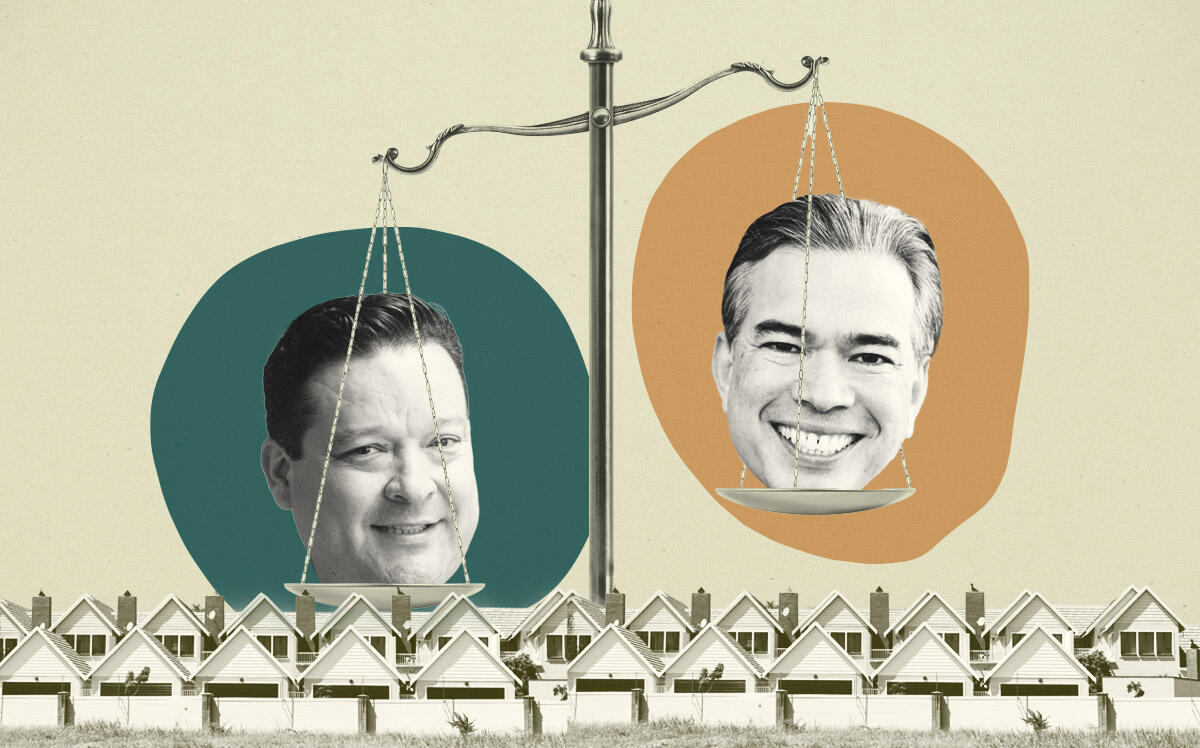In the end, lawyers modified the language slightly and both sides claimed victory — kind of.
“Attorney General Bonta applauds move by Pasadena City Council to come into compliance with SB 9,” cooed the headline of a press release issued from Sacramento last week.
“The Attorney General simply got it wrong,” the mayor of Pasadena countered.
The confusing and contentious communications came three months after California Attorney General Rob Bonta had raised the ire of Pasadena Mayor Victor Gordo by publicly lambasting the city over its passage of a temporary ordinance on SB 9. Pasadena effectively put up a roadblock on SB 9 and its pathway to densification of neighborhoods formerly zoned for single-family homes––an effort similar to moves by various Bay Area municipalities in terms of bottom-line effect, but differing in approach, with a basis in historic preservation.
Bonta, the state’s top law enforcement officer, responded with public remarks that painted the Southern California city of 150,000 or so as a poster child for noncompliance with the new housing law.
Pasadena’s City Council nonetheless went on to pass a measure to codify the temporary ordinance––a move confirmed on May 16, when the body passed a second reading, cementing the measure into city code.
The new, permanent ordinance — endorsed by the attorney general’s office — was nearly identical to the previous temporary ordinance that sparked the fight. But not quite: The debate centered around Pasadena’s SB 9 exemptions for landmark districts––neighborhoods the city deems to have historical or architectural value. The new law, instead of simply referring to the landmark districts, added language explicitly detailing how the city defines them.
“So instead of saying here’s something we call a potato, we just put the potato in,” Victor Gordo, the mayor, said in an interview last week. “We made it easy for him.”
In an emailed statement last week, the attorney general’s office reiterated its stance that the temporary ordinance was “inconsistent with the law” but confirmed that he views the new ordinance as bringing Pasadena into compliance.
It was a strange, nuanced resolution to what has been the state’s highest-profile battle to date over SB 9. The episode also illustrates the high-stakes political chess games playing out in real time between the state and numerous cities over law— and it could offer a kind of preview, with likely implications for the long-term impact of a signature housing law whose first few months have been characterized more by squabbling and confusion than real world effects.
“These are going to be ongoing battles,” Eric Sussman, a real estate professor at the UCLA Anderson School of Management, said earlier this year. “There’s nothing new here in terms of politics and power and division, but unfortunately this particular one has significant and long lasting consequences … This is front and center of what matters to people in the state.”
SB 9, the culmination of a multi-year legislative effort pushed by housing-minded Democratic state legislators, was signed by Gov. Gavin Newsom last September and enacted in January. The law aims to ease the state’s housing crunch by creating a uniform zoning standard, granting any California single family property owner the right to build a duplex or split the lot into two, potentially creating four units on a lot that previously had one.
Proponents of SB 9 say they are meant to add density without significantly altering its look or feel. A widely cited analysis from UC Berkeley published in July predicted the law could eventually add 700,000 units, although the actual number will likely be much smaller because pursuing development doesn’t actually make financial sense for most property owners.
“It’s not a panacea,” David Garcia, a researcher who co-authored the analysis, said last year. “I would say it is a modest, incremental improvement upon California’s existing land use policy.”
While housing groups across the state championed the law — polls also showed it was supported by a majority of California renters and voters in L.A. County — cities across the state, often at the behest of neighborhood groups, have pushed back hard.
The law includes wiggle room for municipalities to implement their own “objective design standards,” and in recent months dozens of municipalities have passed ordinances aimed at curbing its impact. The local measures typically attempt to effectively preclude any SB 9 development by introducing a litany of onerous, often creative new restrictions, such as requirements that any new units must meet corporate headquarters-level LEED standards or that new tenants can’t own cars.
In February, Woodside, a wealthy Bay Area city, attempted to skirt the law by briefly declaring the whole town was a protected mountain lion habitat, a defense that prompted national mockery. The same month, Alhambra, a middle class city in Los Angeles County’s San Gabriel Valley, extended an emergency ordinance with a long list of requirements that included mandates that any new units have setbacks of at least 25 feet, use materials identical to those of neighboring properties, incorporate only “shielded and downward facing” exterior lighting and remain affordable housing for 30 years. (“We would do this for any sort of new development,” the city’s vice mayor told local media.)
It was Pasadena’s measure, though, that prompted the biggest fight to date with the state attorney general’s office.
The city, which ranks among California’s oldest, began designating certain neighborhoods as “landmark districts” in the late 1980s. Neighborhoods themselves initiate the process; to qualify at least 60 percent of homes in the area must be judged to have local historical or architectural significance.
The city now has roughly two dozen such districts, which represent about 20 percent of its land area; the neighborhoods are subject to local design restrictions reviewed by the city’s Historic Preservation Commission, which follows guidelines based on the Secretary of the Interior’s Standards for Rehabilitation, the widely used federal standard for historic building modification.
Pasadena first passed its temporary urgency ordinance in December. The ordinance, while citing the pending law’s “current and immediate threat to public health, safey, and welfare,” declared the landmark districts broadly off limits to SB 9 development.
The final text of SB 9 includes an exemption for properties located within “historic districts,” as well as sites that are “legally designated or listed as a city or county landmark.” But it does not explicitly mention “landmark districts.” Pasadena extended its temporary ordinance in January. Two months later Gordo received a call from Bonta. The attorney general told him he was calling because he was going to issue a violation notice over the measure.
“I don’t want to blindside you,” Bonta added, according to Gordo.
“When are you going to do that?” Gordo responded.
“In an hour.”
Bonta, a Democrat who represented a Bay Area district in the state legislature before being appointed to his current post by Gov. Newsom last year, wasn’t bluffing. The state office promptly fired off a press release, which Bonta summed up in a Tweet: “We’re putting the City of Pasadena on notice for violating SB 9,” it read in part. “I urge cities to take seriously their obligations under state housing laws. If you don’t, we will hold you accountable.”
The public missive also linked to a stern legal letter from the state office addressed to Gordo, calling out both Pasadena’s legal basis for passing an “urgency ordinance” at all and the city’s broad exemption of “so-called ‘landmark districts.’” The measure, it concluded, “is thus contrary to the plain text of SB 9 and cannot stand.”
Gordo, who speaks passionately about his city’s architectural heritage, took the public condemnation personally. He blasted the attorney general’s approach in interviews, including with TRD, and on April 1 published his own open letter to Bonta It was 70 pages, and vigorously defended both Pasadena’s record on affordable housing and its history of historic preservation while railing against the “politically motivated” criticisms coming from certain state officials and “media opinion makers.”
“Going forward,” Gordo wrote, “I respectfully encourage our Attorney General to get to know us before taking to Twitter to wrongfully and unfairly tarnish Pasadena’s good name — by now, we should all understand that governance by Twitter is ineffective.”
The letter also laid out an argument for why the city’s “landmark districts” are, for legal purposes, one and the same as “historic districts,” with both distinctions adhering to the same evaluation criteria with the National Historic Register. And while the final text of SB 9 does not explicitly mention “landmark district,” the letter points out, the term does appear, along with historic districts, as a listed SB 9 exemption on the State Senate’s own website — it was actually Pasadena residents and city staff, Gordo said, who helped their local state senator, Anthony Portatino, craft the bill’s language with Senate President pro Tempore Toni Atkins.
Later this spring, with the dispute still unresolved, Gordo traveled to Sacramento with Pasadena’s planning director and city attorney to meet with state officials. Gordo declined to discuss specifics of the talks, or even confirm that he met with Bonta directly, but the result was an outcome that satisfied both parties: the subtle language additions the city inserted in its new ordinance explicitly outlining the criteria for its landmark districts.
The changes, the attorney general’s office said, narrowed “the definition of landmark district to be consistent with state and federal law definitions of historic districts” — even though what really happened, in the mayor’s characterization, was that the attorney general recognized that the state office recognized that Pasadena had been in compliance all along.
“I think we have the correct outcome,” Gordo said. “It is unfortunate,” he added, “that we had to go through all the rigamarole that we went through.”
Gordo also declined to answer questions about the apparent discrepancy in the tone of last week’s two nearly simultaneous public statements — the attorney general reflecting on a “successful collaboration,” while Gordo panned the attorney general — as well as his current relationship with Bonta.
“Let me say this,” he began, choosing his words carefully. “There’s a big gap between Pasadena and Sacramento. My personal travel and physical travel to Sacramento was intended to bridge that gap.”
Read more


